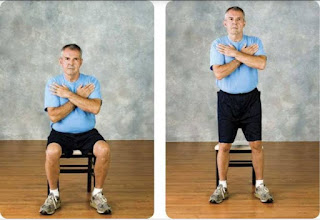POSTURAL DEFORMITIES & CORRECTIVE MEASURES [PART 2].
In the previous session we have discussed about postural deformities in upper body. In today's session we will discuss about some measure postural deformities in lower body and their corrective measures too.
Types of Postural deformities in lower body are -:
1. Flat Foot -
Our feet at the base of support for body while standing, walking, running and jumping. Flat foot is commonly found among newborn babies but it becomes the postural deformity if it still persist during later childhood. The children with flatfoot deformity cannot become efficient sports persons. Flat foot causes pain in feet while running. They face problem while standing and walking.
Causes of flatfoot : The main cause of flat foot is weak muscles. Weak muscles of the foot cannot be the body weight. Hence, the feet become flat or without arches. Along with this, rapid increase in body weight, improper shoes 👟 and carrying heavy weights for a longer period are also the causes of flat foot.
Precautions of flatfoot :
A. The shows should be of proper shape and size.
B. Don't force or encourage babies to work at an early stage.
C. Don't walk bare feet for a longer duration.
D. Children in early childhood should avoid carrying heavy weight.
E. High heeled shoes should be avoided.
Corrective measures for flatfoot :
A. Walking on heels and toes is best remedy for flatfoot.
B. Rope skipping.
C. Perform sit ups on heels and toes.
D. Drop some stones in one bucket and now try to pick them out with help of your toes.
2. Knock-knees -
Knock knees is one of the major postural deformities in lower body. In this deformity both the knees knock or touch each other while in normal standing position the gap between the ankle goes on increasing. The individual faces difficulty in walking and running. We cannot walk or Run in a proper manner. Owing to this deformity people cannot be good players and may not be selected in defence services.
Causes of knock-knees : Generally, the lack of balanced diet, especially Vitamin D, calcium and phosphorus is the main cause of Knock knees. It may also be caused due to rickets. Chronic illness, obesity, flat foot and carrying heavy weight in early age may be other possible causes of Knock-knees.
Precautions for Knock-knees : Generally it is hereditary so there are very less precautions of knocked knees. Some of them are maintaining a proper balanced diet and the baby should not be forced to walk in early age .
Corrective measures for Knock-knees :
A. Horse riding is best exercise for remedying and correcting this deformity.
B. Use of walking calipers may be beneficial.
C. Perform padmasan and gaumukh aasan regularly.
D. Keep a pillow between the knees and stand straight for some time. Both the feet should be touching each other.
3. Bow legs -
Bow legs is also a postural deformity in lower body which is very common in today's world full stop it is opposite to knock knees position. If there is a wide gap between the knees when standing with feet together, the individual has bow legs or genu varum. In this deformity, knees are wide apart. This deformity can be easily observed when an individual walks or runs.
Causes of bow legs : The main cause of bow legs is the deficiency of calcium and phosphorus in bones. Long bones of legs become soft, hence they are bent outward. The chances of bow legs also increases when children become overweight.
Precautions for bow legs : Avoid overeating is the best precaution for bow legs. Don't force for encourage babies to work at an early stage, balance diet should be given to children. There should not be any deficiency of calcium, Phosphorus and Vitamin D in the diet.
Corrective measures for bow legs are :
A. Walk by bending toes inwards.
B. Perform ardhmatseyendrasana, garudasana and ardha chakrasana regularly.
C. Bow legs can be corrected by walking on inner edge of the feet.
D. Vitamin D should be taken in adequate amount.






Comments